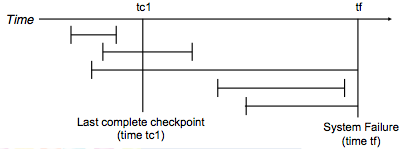










Finish Logging and Recovery; Startup Restart
CS185c
Chris Pollett
May 4, 2010











CS185c
Chris Pollett
May 4, 2010
The main components of a checkpoint is as follows:

Unlike a unit of recovery record, which is specified for transactions and driven by SQL statements, a checkpoint is a system-wide event. It can be scheduled by a system parameter, or triggered by a coordinator like IMS/DC, CICS, DB2's LOGLOAD, or by stopping DB2, etc. Checkpoints are also taken:
Which of the following statements is true?
You can use the new BACKUP SYSTEM utility to back up an entire DB2 subsystem or an entire DB2 data sharing group.
The BACKUP SYSTEM utility provides two options that you can specify:
This whole process might take a while.
We next look at the phases of recovery for a normal restart.